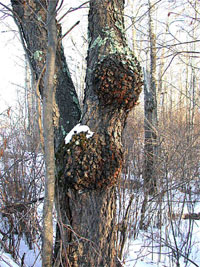About Spalted Wood and BurlThe spalting that we find so attractive is the visible changes to the wood resulting from fungal attack which is part of the natural decay process. Individual spalting patterns on a specific piece of wood are unpredictable. There are many variables affecting the process. These include wood species, temperature, humidity, pH, adjacent soil types, fungus spores in the local environment, and probably many other variables I haven't identified. Many times only a small portion of a log will have usable spalting. The remainder may simply decay without developing a spalt pattern. Many types of wood will spalt. Some such as maple and birch are known for a more attractive spalting appearance and remain usable further into the spalting (decay) process. Looking for spalted wood is like going on a treasure hunt. After a long walk thru the woods I may end the day empty handed or find one beautifully spalted dead log that will keep me busy for weeks. It is possible to make your own spalted wood, but it also can be an expensive and time consuming way to turn expensive lumber into humus!
Pictured to the right are two decent sized burls on a 12" diameter wild cherry tree. This tree appears relatively healthy and will probably live many more years. The Aspen burl pictured above weighed over 200 lbs (20 inch diameter on a 10 inch diameter trunk). I found it on a storm downed tree only a few hundred yards from our house. The cut angle of the half section does not show the full beauty of the burl which will be revealed as the burl is sectioned. This is the largest aspen burl I have seen, and there are tens of thousands of aspen within a mile radius of our house. Some burls are regular growth rings growing at an accelerated rate. These types aren't as interesting to look at and aren't as widely known. The type of burl preferred by most woodworkers is the type that grows in wild irregular swirling patterns with "eyes". These are particularly noticeable in some of the closeup pictures of cherry burl on the picture page. The irregular swirling growth habits of burl that makes it so beautiful also makes it unstable and difficult to work.
Burls vary in size from a few ounces to several tons. In Northern Wisconsin a burl over 150 lbs is exceptional. We obtain our Burls from dying trees and local loggers. Burls don't appear to do a very good job of passing nutrients to the tree. My experience is that once a burl completely girdles a tree trunk the tree will die. Spalted woods may have soft spots that are too far along in the decomposition process to be workable. The unpredictable shrinking warping and cracking in burl is due to variations in density and lack of regular grain pattern. For that reason both these woods are often stabilized to retain the natural beauty while imparting good physical properties to the material.
|
 Burls
Burls
